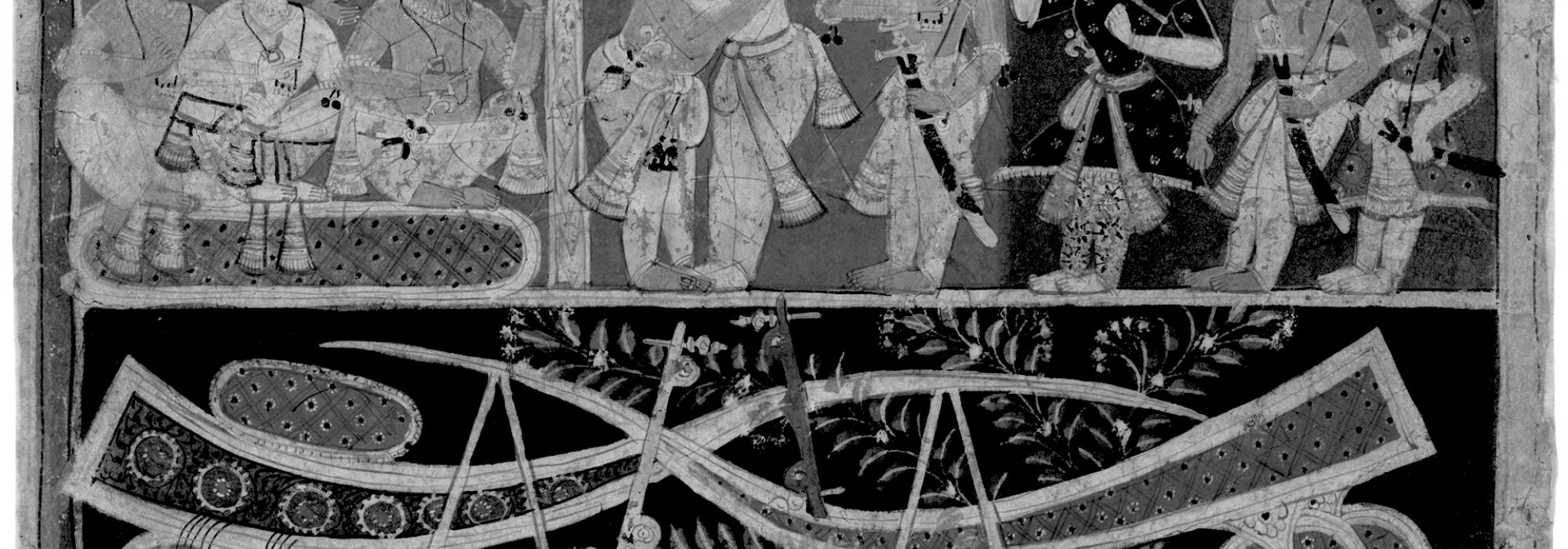Characteristic of the Yuga
WHAT WE NEED TO CONSIDER here is the inextricable relationship between Dvāpara and Kali and the manner in which that relationship shows us differences in Dharma. And further how the propensity of gambling became widespread in the psyche of the people. What Kali showed in the story of Naḷa was jealousy and ill-will. The word Kali variously means “quarrel,” “corruption,” “disturbance,” and “filth.” The root of all these qualities are jealousy and intolerance.
What is Time?
We normally speak of changed times. But what does that really mean? Time signifies a temporal circumstance—the scenario of the present reality around us. The seeds of the future are contained in the womb of some human circumstance.
Let us assume that someone places a fragrant plate of a variety of dishes before a hungry person. The seeds of haste that will eventually finish off the dishes on the plate are contained in the hunger in his stomach and in the aroma of the food. When the person who put the plate there returns after some time, he sees a half-empty plate. This is the difference caused by time. Meaning, the duration required for hunger and fragrance to do their work is the work of time. The hunger and the aroma did not wait for an external motivation or command but did their work on their own. Which further means that it was time that awakened the hunger and the sense of smell which were seemingly asleep till then. On their own, hunger and olfaction are inert. When both are fused together, both cast away their inertia and come to life. The exact moment of their fusion denotes time in that context. In this manner, time is the fusion of Karma or activity. A bud blossoming into a flower, a seed that ripens into fruit is the work of the season. Likewise, the mind and the intellect of a human being, too, ripens owing entirely to his experiences in the world over a period of time. The seed that is planted in the earth does not sprout immediately. It needs several hours for the nutrients in the seed to mature and show as sprouts. Thus, the time required for our inner strength to blossom is what we mean when we say “changed times” or “changing times.” Time is the authority behind the temporal process by which objects are either ripened or spoiled. The Veda lays down thus:
sūryo॒ marī॑ci॒māda॑tte । sarvasmādbhuva॑nāda॒dhi । tasyāḥ pākavi॑śeṣe॒ṇa । smṛ॒taṃ kā॑lavi॒śeṣa॑ṇam । na॒dīva॒ prabha॑vātkā॒cit ।a॒kṣayyātsyanda॒te ya॑thā ॥ tānnadyo'bhisa॑māya॒nti । so॒russatī॑ na ni॒varta॑te । e॒vannā॒nāsa॑mutthā॒nāḥ । kā॒lāssaṃ॑vatsa॒ragg śri॑tāḥ । aṇuśaśca ma॑haśa॒śca । sarve॑ samava॒yantri॑tam । sataissa॒rvaissa॑māvi॒ṣṭaḥ । ū॒russa॑nna ni॒varta॑te । adhisaṃvatsa॑raṃ vi॒dyāt । tadeva॑ lakṣa॒ṇe ॥ (Taittarīya āraṇyaka 1-4.5)
The Sun, through his rays, ripens and perfects all objects in this world. The course of time is understood through the changes brought about by the heat of those rays of Surya. Akin to a river flowing from a never-drying source, the river named Time flows from Surya. The flood of time (kā॒lā pravāham) is linked thus directly to the hot rays (marī॑ci) of the Sun. From different directions, smaller rivers flow and join that big river. Thus, the great river of Time swells in volume and does not dry up or reverse its course. Thus, the smaller units of time (such as seconds, minutes hours, days) and larger units such as months, seasons, and solstices flow towards and reach their confluence with the mighty river of Time and become one. With this marker (lakṣa॒ṇam), we must comprehend that this boundless and limitless flood of time will transcend measurements such as year. Time is akin to a River.
Similar to this unbroken flow, our ancients have categorized the River of Time as Samvatsara, yuga, kalpa, manvantara, samvarta, praḷaya, kalpānta, etc. Of these, the Four Yugas are relevant to our present context. We can briefly examine this aspect.
We have already seen some facets of each Yuga. But we need to ask this question as well: is this conception of Yuga a mental conception or is it guesswork based on experience?
The Motion of the Wheel of Time
Some philosophers of the West pose a question. Every person passes through three phases in life: childhood, youth and old age, as ordained by nature. Likewise, does a race of people or a nation also undergo the similar phases of senescence and decline? If so, is it natural and inevitable? Just an individual person so a society—are man-made divisions of family, lineage, and class naturally subject to old age, decline? Are they unresolvable?
Nīcairgacchatyupari ca daśā cakranēmikramēṇa ||
The spokes of the wheel of Time are growth and destruction or youth and old age. These are ascendant for some period and descendant at others.
But what does history tell us? When we examine the historical evidences available in the form of stone and other inscriptions discovered so far, it appears that the most ancient civilisations of the world include the Egyptian, Babylonian, Chaldean, Assyrian, and Mesopotamian. All these flourished about eight or ten thousand years ago. Today, some of these have been lost and some are untraceable. Other civilisations resembling Egypt are being newly discovered. Due to some unseen fate, they have been completely marred and no traces of their former glory are visible.
What is relevant to us in all these ancient civilisations in the present context falls in the realm of the human world: strength, power, adventure, wealth, prosperity, and glory. The evidence for a sense of Dharma is not clear. There seems to be no mention of Atma as well.
To be continued
















































